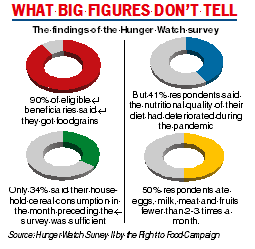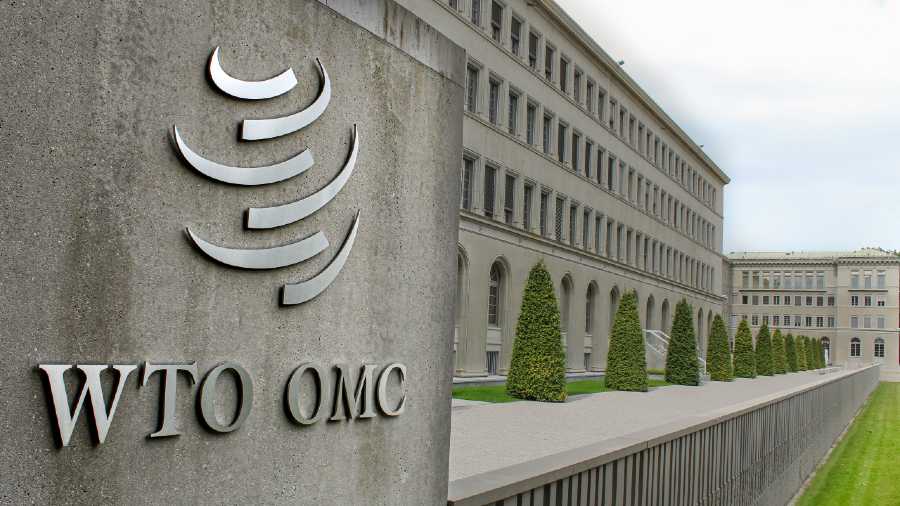The marginalised sections have continued to face food insecurity in the aftermath of the Covid-19 second wave last year as families suffered income loss, suggests a survey-based report released on Wednesday.
The Hunger Watch Survey II, conducted by the NGO Right to Food Campaign during December 2021 and January 2022 to assess the situation of food insecurity after the deadly second wave that peaked early-May, found that 41 per cent of the respondents had witnessed a deterioration in the nutritional quality of food during the pandemic. (See chart)
As much as 60 per cent households said they were worried about food or unable to eat healthy food or were unable to eat as much of or the type of food they would have wanted to in the month preceding the survey.
This segment had eight questions — whether they were worried about not having enough food, were unable to eat healthy or nutritious food, ate only a few kinds of food, had to skip a meal, ate less than they should, ran out of food, were hungry but did not eat or went without eating for a whole day. For an affirmative answer to any one of the eight questions, the surveyors marked a respondent as part of the entire segment.
Only 34 per cent of the 6,697 respondents reported that their households’ cereal consumption in the month preceding the survey was sufficient. Half of the respondents ate egg, milk, meat and fruits fewer than two to three times a month.
The survey’s findings fly in the face of the government’s claim that it is running a robust food assistance programme amid the pandemic.
“Compared to the findings of the first round of the survey, the second round shows marginal improvement but there is still a long way to go to return to the pre-pandemic levels of 2020,” said Deepa Sinha of the Right To Food Campaign.
The first leg of the survey — Hunger Watch I — conducted during October-December 2020 after the first Covid wave had found that 71 per cent of the respondents did not get a wholesome meal in the month preceding the study. The NGO Centre for Equity Studies had also been part of that survey.
Among Hunger Watch II’s 6,697 respondents, 1,992 were from Bengal — the highest among the 14 states surveyed.
Among the respondents, 31 per cent were Scheduled Tribes, 25 per cent Scheduled Castes, 19 per cent general castes, 15 per cent Other Backward Classes and 6 per cent Particularly Vulnerable Tribal Groups. Women made up 71 per cent of the respondents, who were from rural areas and slums in urban centres.
About 18 per cent of the households surveyed had a child who had dropped out of school during the pandemic, while 6 per cent of the households reported a kid below the age of 14 working in the fields or at business establishments to supplement family income.
Only 5 per cent households earned more than Rs 15,000 a month from all sources while 70 per cent families earned less than Rs 7,000 a month.
About 66 per cent of the respondents reported that income fell during the pandemic. Among those who reported income loss, 59 per cent said their earnings were now less than half of pre-pandemic levels and 26 per cent said earnings were between half and three-fourths.
Two-thirds, or 67 per cent, of the respondents could not afford cooking gas in the month preceding the survey.
The government provided an extra 5kg of free ration per person per month for the beneficiaries of the National Food Security Act during the second wave, till November 2021. This was in addition to the regular subsidised food provided to them under the public distribution system (PDS).
The Hunger Watch Survey II found that 84 per cent of the households had a ration card and over 90 per cent of the beneficiaries had received food grains. But many did not receive midday meal and nutritional support for pre-primary children.

Economist Sunil Ray, former director of the A.N. Sinha Institute in Patna, attributed the findings to the decline in jobs and income.
“If people have income and money, they will spend on food and other consumption. They need to have a stable income from either formal or informal jobs or self-employment. On this front of employment and income, the situation was bad during the previous government and has worsened under the current government,” he said.
According to Ray, the economic policy of promoting big corporates was not having a trickle-down effect in terms of jobs for the common people.
“What will the country do with growth rate if it continues to have no relevance for 70 to 80 per cent of the people? What is required is localised entrepreneurship where small manufacturing units can be set up to utilise the local resources for producing goods and services,” Ray said.
For example, agriculture-based industries can be started in rural areas depending on the production of crops and these businesses can perform activities such as processing, storage and transportation. Similar initiatives can be started by local education service providers to impart skill and healthcare training and manufacturing. The government has to provide some assistance for starting such units, Ray said.
He said the government’s argument that it had provided subsidised and free food during Covid may be correct but it was excluding many who deserved the assistance.
“Has the government ever studied if all 80 crore people getting subsidised food under the National Food Security Act (NFSA) really deserved the benefit? What administrative mechanism has the government put in place at the local level to determine who deserves the benefit and should be fed under the NFSA? There is a lot of corruption,” Ray said.
He said “power relations” at the local level played a role in determining who would receive benefits. The marginalised sections such as casual labourers and migrant workers tend to be deprived of government benefits, Ray felt.
“Instead of claiming success, it may be worthwhile for the government to find ways and means to eliminate systemic institutionalised biases or distortions at the local level that inhibit the distributive flow of food to the hungry Indians,” Ray said.
Reetika Khera, faculty member of economics at IIT Delhi, said it was not as if the government had not done anything. For example, it did double PDS wheat and rice for those who have ration cards.
“But compared to what was required, the government’s efforts have fallen short. Two major and urgent actions that were required have received no attention. One, expanding the coverage of the PDS to include those who do not have ration cards. Two, include items such as dal and oil in the PDS. Again, neither of these has been acted upon,” Khera said.
The government should have opened community kitchens for stranded migrants workers, she said.
Under the Integrated Child Development Programme, which supports nutrition to pre-primary children, the budgetary allocation in 2014-15 was Rs 18,691 crore, which works out to Rs 27,615 crore at current prices. The budgetary allocation for the scheme in 2022-23 is Rs 20,263 crore, Khera pointed out.












